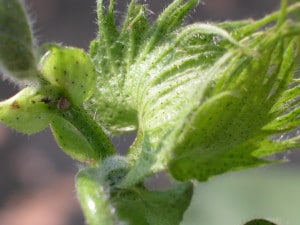
Below are a few reminders as much of the crop will begin squaring in the next week. It’s too soon to know what kind of plant bug year we will have, but there are a couple of truism that generally hold. When we have a wet spring, and particularly a cool spring, infestations in cotton often start a little later than normal. The weedy hosts of tarnished plant bug will stay attractive longer, holding the bugs longer before they migrate into cotton. However, we often since higher than normal populations during mid and late season under the same circumstance. Second, plant bug infestations tend to be higher when cotton acreage is low. Thus, I’m not expecting any reprieve from plant bugs in 2020.
- The very first fields that begin to square often receive the brunt of the plant bugs until more fields start squaring. Watch them closely.
- Prior to bloom, if a square is shed, you can bet the farm it is related to insect injury, and 9 times out of 10, plant bugs are the cause.
- Monitoring square retention is a great way to see if plant bugs are causing problem and evaluating if insecticide applications are working. If square retention stays steady even when it seems like insecticide applications are not working, then they are working.
- The goal is to maintain at least 80% square retention through early bloom. There are a number of methods to count square retention. It is often suggested to focus just on first positions, but the most important thing is to count the number of missing squares in ‘X’ number of fruiting sites. You’ll want to look at multiple plants in several, representative places of the field. Usually, checking retention for 100 total fruiting sites is enough, especially if square retention is well above or below the 80% mark, but you may want to look closer when you are riding the edge.
- Don’t waste time digging around for tiny squares in the terminal. They don’t tell you much. Even if damaged, they probably haven’t had time to shed.
- Use a sweep net! This is the best method of monitoring for plant bug adults during the first 3-4 weeks of squaring. Take 25 sweeps at a minimum of four locations in a field. The threshold during the first two weeks of squaring is an average of 8 plants bugs per 100 sweeps (either tarnished or clouded). I would reduce this threshold if square retention drops below 85%, but how much requires a little judgment based on the square retention.
- During the first two weeks of squaring, I think full rates of imidacloprid, Centric at 1.75-2.0 oz per acre, or combinations of these two product will protect against square loss, despite some “slippage” of efficacy. Transform at 1.5 oz/acre is another option and Vydate at 10-12 oz/acre is worth consideration, but honestly, I’d try to reserve those products until at least the third week of squaring and beyond. Once we hit the third week of squaring, mixing in Diamond at 4-6 oz/acre is common to delay and reduce the build-up of nymphs.

